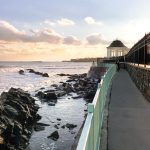Block Island, RI: Snorkeling
Here’s how you find snorkeling in the “garden” in the ocean near Block Island. It’s about 250 paces from my cubicle at the Block Island Times, out the back door, across Corn Neck Road, and down the sand-dune path lined with Rosa rugosa, where I come to Crescent Beach. There’s nothing between me and Portugal. […]
Here’s how you find snorkeling in the “garden” in the ocean near Block Island. It’s about 250 paces from my cubicle at the Block Island Times, out the back door, across Corn Neck Road, and down the sand-dune path lined with Rosa rugosa, where I come to Crescent Beach. There’s nothing between me and Portugal.
Actually, there is “the rock”–a glacial dropping (like the rest of the island) perhaps 75 yards distant. At high tide it’s the one topographical constant, a beacon above the surface, providing a distinctive Jupiter’s eye on the otherwise featureless sea (although a backbone of satellite rocks, sporting rockweed dreadlocks, does appear when the tide drops). Some call it “Guano Rock,” given its snowy peak. In the 1940s my mother called it “Barnacle Bill” and swam to it with friends to chew seaweed. Maybe half a dozen adults could crowd upon it.
New England diving has a reputation for cold water with limited visibility. But between late May and October, I try to get out to Bill and the surrounding area as often as possible. With each successive kick, the water becomes deeper, clearer, and more revealing of the brilliant and salty parade. I encounter swaying eelgrass with turquoise, rock-lined grottos in between. Still giddy after four decades of exploration, I wonder: What cool creatures could lurk just beyond the next undulating curtain of green?
Fish. There’s the ubiquitous cunner (choggy, bergall), not to be confused with the juvenile tautog, or “blackfish”–which can grow to resemble a grouper. Sometimes patrols of striped bass swim through, so thick you don’t try to count. Ditto the bluefish–though they move like quicksilver and are gone before you can be sure they were there. Then there’s the juvenile black sea bass, which somehow transforms from a benign ochre-colored fish to a dark, pointy, scaly thing that looks like a mini-coelacanth. As a kid I was entranced by my uncle’s tales of encounters with “sand sharks” (actually smooth dogfish) here in the 1960s. Now I see “Sandy” all the time. They look and move just like the sharks they are.
Friends have started to call this place “the Garden,” and I think it fits. It’s in the wild, yet the cornucopia of life here seems as though it could only be the result of an inspired underwater landscaper or custom aquarium designer. I once chanced to see a sea raven–otherworldly red, with a spectacular display of filigreed fins and indignant, bloodshot eyes. Once I peered under a rock expecting yet another lobster, but found myself face to face with a conger eel. Just the other day I joined a dozen triggerfish hovering over a skate. A night dive revealed a network of blue crabs to make Maryland jealous.
I’ve dived in the Caribbean and off Central American shores and seen wonderful things, and friends have explored the even more amazing Micronesia and the Red Sea. Yet everyone finds this spot enchanting. And it’s right here, just out the back door.
When You Go
Block Island Parasail and Watersports
Sunset cruises, snorkeling trips, and sightseeing tours. Old Harbor Dock. 401-864-2474; blockislandparasail.com
Block Island Chamber of Commerce /Tourism Council, 800-383-2474; blockislandinfo.com
More Travel: 10 New England Weekends







